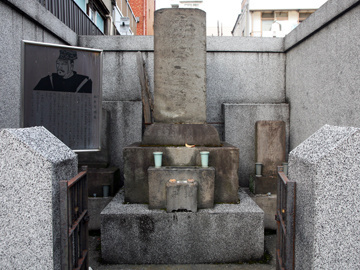
01. Tomb of Hosoi Heisyu
Metropolitan Historic Site
Tengaku-in Temple, 3 chome 14-1, Nishi-asakusa
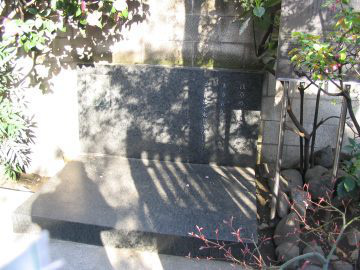
02. The Monument to Ishikawa Takuboku
Toko-ji Temple, 1 chome 6-1, Nishi-asakusa
Ishikawa Takuboku was born in Iwate Prefecture in 1886. He began writing poetry at an early age however, due to his father's loss of employment, it was necessary that he worked in order to support his family. Working as a teacher in his hometown, a newspaper journalist in Hokkaidō, and doing other jobs, he moved from place to place.
In 1908 he came to Tokyo to begin his life as a writer. From 1909 he strove to write novels and tanka poetry while working for the Tokyo Asahi Newspaper. In December of 1910 he published his first poetry collection "A Handful of Sand" which received great critical acclaim.
However, while enduring an impoverished lifestyle, he contracted tuberculosis and on April 13, 1912 he passed away (age 27) in the house he rented in Hisakata-cho, Koishikawa City. His funeral was held at Toko-ji Temple that was the place his close friend Toki Zenmaro (Japanese literature scholar and poet) was born.
This monument was erected in 1955 on what would have been his 70th birthday. The following poem is inscribed upon the face of the rock:
A sad soul-
In the excitement of the Asakusa night,
Coming and going with the crowd.
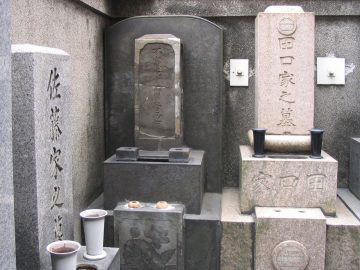
03. Tomb of Yamada Souhen
Metropolitan Historic Site
Ganryu-ji Temple, 1 chome 2-16, Nishi-asakusa
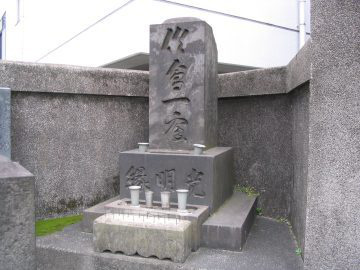
04. Tomb of Oda Tokuno
So-on-ji Temple, 1 chome 6-7, Nishi-asakusa
Oda Tokuno was a monk in the Meiji Period. After studying Buddhism, he edited “Sangoku Bukkyo Ryakushi,” which contains brief histories of Buddhism in India, China, and Japan. Later, he became the chief priest of the So-onji Temple priesthood. He compiled “Bukkyo Daijiten” (Great glossary of Buddhism) in the storehouse of the temple from 1899 to 1911 when he died. The glossary was published in 1917 based on his draft. He was buried in the tomb of the priests of this temple.
The monument bearing the carving “NENBUTSU JOBUTSU” which means attaining Buddhahood while chanting a prayer, was erected in 1994 by the then chief priest and supporters of the temple.
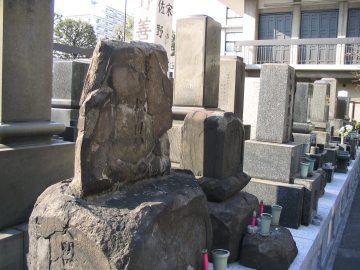
05. Tomb of Sano Zenzaemon Masakoto
Tokuhon-ji Temple, 1 chome 3-11, Nishi-asakusa
Masakoto wounded Tanuma Okitomo, the ruler at the time, in the Room “Chinese Bell flowers” in the Edo Castle on March 24, 1784. Okitomo died on the next day, and Masakoto committed suicide by disembowelment on April 3. Of the same year, thereby his life ended at the age of 28.
Tanuma's politics were strongly influenced by the connection with concession and was criticized for the receipt of bribes. Furthermore, famine and conflagration continued, prices rose suddenly and therefore the people uttered voices of reproach. On the day following the death of the self-serving Tanuma, however, high rice prices went down and Tanuma Okitsugu, Okitomo’s father lost the post of “Roju”. Subsequently, many people came to offer prayers to the tomb of Masakoto at the Tokuhon-ji Temple, calling him a “great human god who changed the Society for the better.”
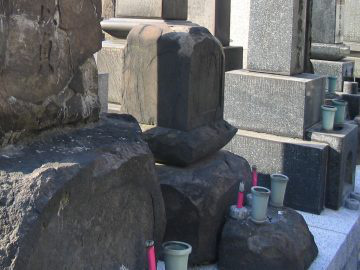
06. Tomb of Sō Shiseki
Tokuhon-ji Temple, 1 chome 3-11, Nishi-asakusa
Sō Shiseki was a painter in the middle of the Edo Period. He went to Nagasaki to learn painting techniques and became a disciple of Kumashiro Yuhi, who precisely succeeded to the techniques of real pictures of Shin Nanpin, a Chinese painter in the Ching dynasty. Furthermore, he was taught the techniques by Sō Shigan and became an independent painter. Returning to Edo, he greatly spread the Nanpin school.
The Nanpin school is the mainstream of modern Japanese painting, and it is revived the thought of realistic drawing in traditional Japanese pictures. Its representative was So Shiseki.
In his tomb at the Tokuhon-ji Temple, Shiseki, his son Shizan and, grandson Shikō were buried jointly. This temple was also famous for the storage of many Sō Shiseki's masterpieces.
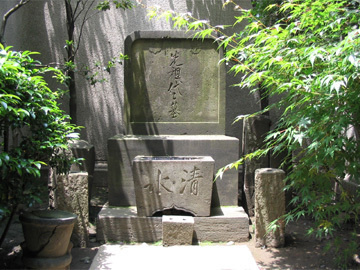
07. Tomb of Shimizu Hamaomi
Zenshon-ji Temple, 1 chome 4-15, Nishi-asakusa
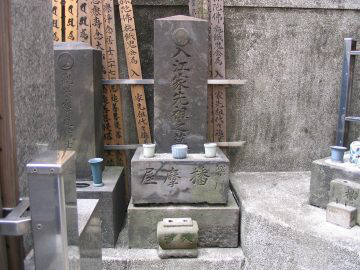
08. Tomb of Izu Chohachi
Shojo-ji Temple, 2 chome 1-2, Matsugaya
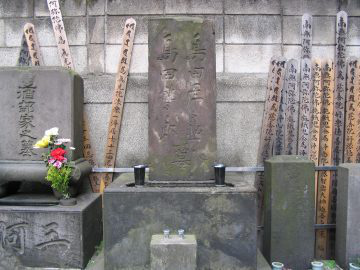
09. Tomb of Shimada Toranosuke
Shojo-ji Temple, 2 chome 1-2, Matsugaya

10. Tomb of Tamagawa Shoemon and Seiemon
Metropolitan Historic Site
Shotoku-ji Temple, 2 chome 3-3, Matsugaya
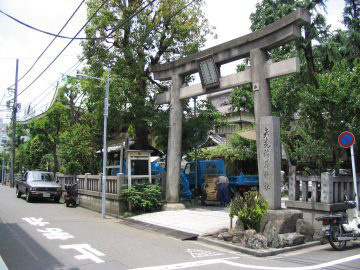
11. Remains of Asakusa Sanjusangen-do
2 chome 14-1, Matsugaya
Asaknsa Sanjusangen-do was built at this archery practice range by Yumishi (bow maker) Bingo in 1642 along the lines of the famous Sanjusangen-do in Kyoto, The sport of shooting arrows from one end of the building to the target at the other end was very popular at that time. A fire destroyed the building in 1698 and three years later, it was reconstructed at Fukagawa in Koto City.
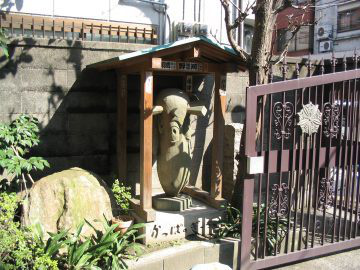
12. The Folklore of Kappa-dera Temple
Sōgen-ji Temple, 3 chome 7-2, Matsugaya
The common name of Sōgenji Temple is Kappa-dera. A Kappa is a mythical creature that is said to live in water.
According to a legend, at the beginning of the 19th century there lived in the vicinity a raincoat maker named Kappa Kawatarō. In Japanese the word for "raincoat" is also "kappa". This was once a basin with poor drainage; therefore, rains would often bring floods causing undue trouble for the residents. Because of this, Kawatarō began the construction of a series of drainage ditches with his own finances. The project was said to have been completed only with the assistance of the kappa living in the Sumida River whom had been helped by Kawatarō in the past. It is said that those, who actually witnessed the river kappa thrived in business.
This legend is the origin of the name "Kappa-dera". Furthermore, the name of "Kappa bashi” (a bridge that once stood at the Kappa bashi intersection) is also said to come from this legend. At the temple they celebrate the Kappa Daimyojin and there is a stone monument that is said to be Kappa Kawatarō's grave.
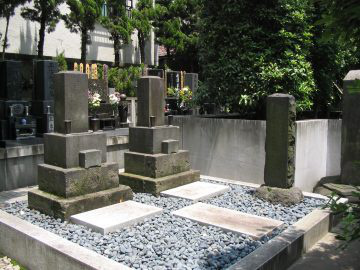
13. Tomb of Umeda Unpin
Kaizen-ji Temple, 3 chome 3-3, Matsugaya
Born in 1815, Umeda Unpin was a clansman of the Obama clan residing in Wakasa-no-kuni (present Fukui Prefecture).
He mastered orthodox Neo-Confucianism and taught at Ohtsu and Kyoto. He was later banished from the Obama clan because he criticized the Shogunate Government, so but in association with Fujita Toko, Sakuma Shozan, and Takasugi Shinsaku, he pushed for advocating reverence for the Emperor and for the expulsion of foreigners. He guided supporters at Kyoto along with Yanagawa Seigan. His activities always concentrated on criticizing the Shogunate Government, he plotted to depose Ii Naosuke, who was a Roju (member of the shogun's Council of Elders) and an advocate for opening ports to foreign ships, Umeda was arrested in 1858 during the mass executions of the Ansei Period for his plotting. The next year, he died from illness while in jail.
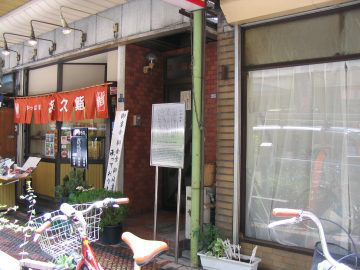
14. The Site of Kappa-bashi Bridge
3 chome 7-2, Matsugaya
This bridge stood at Kappa-bashi Crossing to the west of here. It was about 4 meters long and 11 meters wide, but in 1933 it was destroyed. The waterway underneath the bridge was known as Shinbori-gawa River, or Shinbori. The date of construction of the bridge is unclear, although it appears in a map published in 1671. Possibly because there was a shop selling raincoats (kappa) nearby, it was called Kappa-bashi Bridge.
Folklore has it that from 1804 to 1817 a raincoat seller called Kihachi obtained the help of a Kappa (water sprite) living in the Sumida River and, using the money he had made in his business, constructed the Shinbori waterway. As the word "Kappa" has these two different meanings, either or both of them could explain the origins of the name of the bridge.
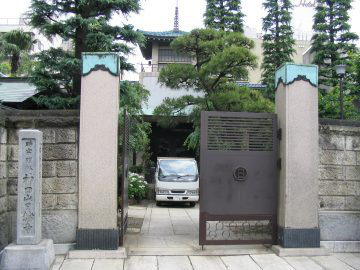
15. Nichirinji Temple
3 chome 15-6, Nishi-Asakusa
According to an oral tradition, Nichirinji Temple was established by the Tendai sect in Shibazaki-mura in Musashi-no-kuni (Present Otemachi in Chiyoda City) in the 9th century. In the beginning of the 14th century, Taa Shinkyo, a high-ranking priest of the Jishu sect, pacified and enshrined the departed soul of Taira no Masakado (a warlord who raised a great revolt in the 10th century) in Kanda Myojin. Shinkyo changed the Nichirinji Temple to a temple of the Jishu sect at the request of the people and priests of the village. In the beginning of the Edo Period, the location of the Nichirinji Temple was changed several times due to urban development and emergency restoration. It is not known exactly when the temple moved to the current location; one theory says around 1603, another says around 1657.
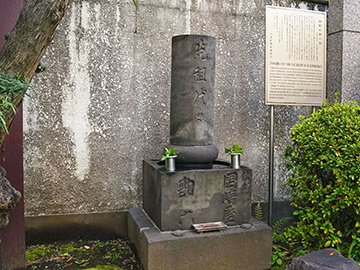
16■Tomb of Okazakiya Kanroku
Seiko-ji Temple, 1 chome 7-19, Nishi-asakusa
Okazakiya Kanroku was said to be the originator of the Kanteiryu style of calligraphy, used exclusively for Kabuki programs and billboards. Kantei style calligraphy originated when Kanroku was asked by Nakamuraza, a Kabuki theater, to write a billboard for Kyogen. He continued to write billboards for Nakamuraza and In Tenmei Period (between 1781 to 1788), his unique calligraphy style was in vogue, together with "shibaie" or dramas of the day.
Now buried at this temple, until his death at the age of 59 in 1805, Kanroku devoted his life to writing letters on billboards and programs for theaters. Even now, his writing style is preserved and used at the Kabukiza theater.













